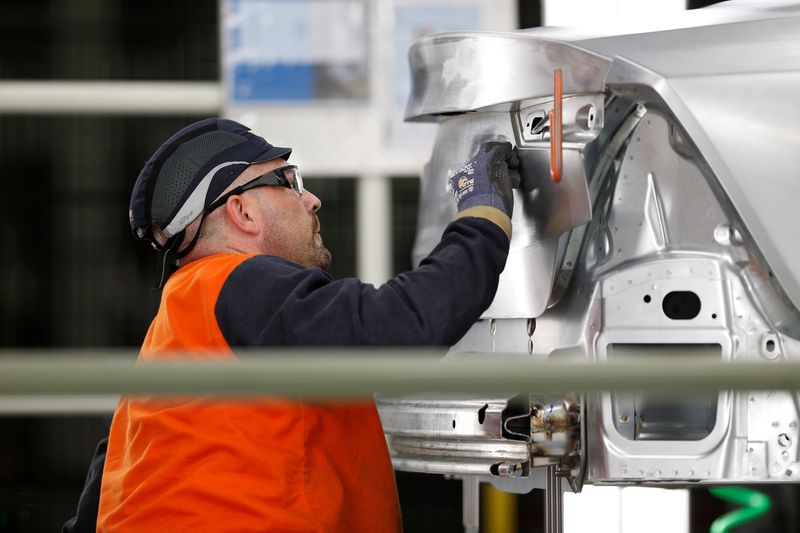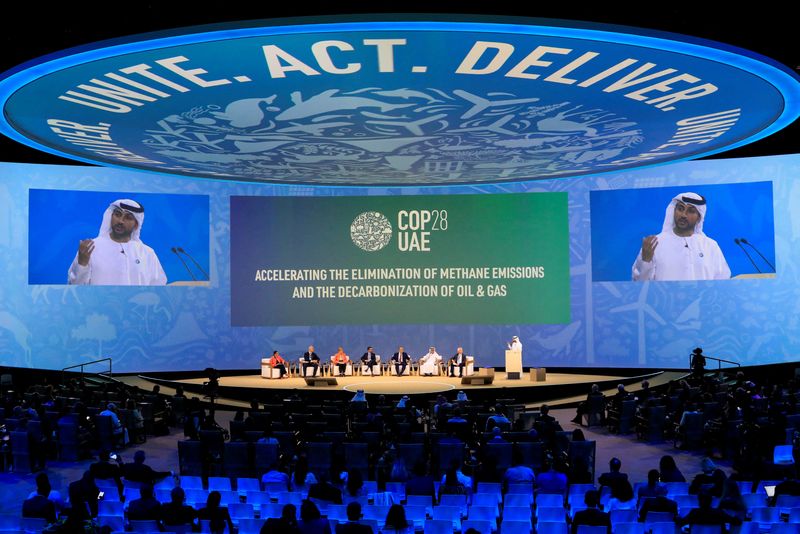By Ross Kerber, Simon Jessop and Peter Henderson
BOSTON/DUBAI/SAN FRANCISCO (Reuters) - A growing list of global companies are setting a price or charging themselves for each metric ton of their carbon emissions, looking to shape their investments and business for future pollution taxes or other new climate rules.
Their prices are all over the place, from less than $1 per metric ton of carbon emissions to $1,600, the most of any company worldwide, set by California drugmaker Amgen (NASDAQ:AMGN).
Regulators, too, have offered a range of prices, including the Biden administration's "social cost" of carbon, around $200, and a suggestion from the International Monetary Fund that it should be at least $85 by 2030.
Incorporating the cost of carbon dioxide and other greenhouse gas emissions into business decisions has been a dream of climate activists for decades as a way to force corporations to cut emissions.
While a standardized global carbon price is not going to be set at the COP28 climate summit underway in Dubai, the concept has many uses in business such as enabling executives to charge their own divisions extra to use power from fossil fuels, thus making renewables more attractive.
"While there are other strategies to do so, failure to use this tool could imply that companies may be failing to adequately plan for the medium- to long-term realities of the cost of carbon," said Amir Sokolowski, global director for climate change at CDP.
An analysis by the non-profit for Reuters found that 20% of 5,345 global companies making climate-related disclosures said they used an internal carbon price last year, up from 17% the year before. Another 22% planned to do so in the next two years, although historically only a fraction of the companies that planned to implement one have done so.
The analysis from CDP, not previously published, reveals both that companies have embraced the new planning tool but also that much debate remains about what prices will spur significant action by companies to cut emissions.
Shown the trends, several analysts told Reuters the emerging picture is one of executives getting ready for some type of new emissions regulation even if they lack a clear sense of what's ahead.
Companies are "getting ready for the reality that it’s going to be required" said Columbia University economist Joseph Stiglitz. But the median prices are still too low to have a major impact on corporate decision-making, making the effort a "mixed bag", the Nobel Prize winner said.
Companies do not have a simple path to follow, since using a high carbon price can dramatically change investment plans, while using a low one can bring charges of "greenwashing."
Several executives who spoke with Reuters said internal pricing plans help them cut emissions and clarify the implications of capital spending and other business activities for the planet.
Market prices for carbon offsets can range from $5 to $1,500 a metric ton, said Joe Speicher, chief sustainability officer at software maker Autodesk (NASDAQ:ADSK).
Autodesk has steadily raised its internal carbon price to $20. Ideally regulators would clarify how companies should treat emissions costs, Speicher said. "Wouldn't it be nice to have a public authority to help to create a more coherent market?" he said.
The company uses the price to help identify things like the value of its investments in carbon-removal projects, he said.
TYING IN TO MARKETS
Various carbon markets operate globally, including the European Trading System (ETS), where carbon currently trades around $70 per metric ton.
British Airways owner IAG in its CDP disclosure offered a range of internal carbon prices from 10 to 130 euros (about $11-$140) per metric ton that are used in connection with or to prepare for different regulations and agreements, including UK emissions targets and ETS compliance.
Different regulatory approaches have resulted in a range of prices around the globe, said IAG Sustainability Insights Manager Michael Evans.
The multitude of price by companies reflects many different factors, he said: "Variations in carbon prices can reflect wider economic outlooks, levels of financial investor interest, and even energy demand."
Many companies have designed their own internal mechanisms. When carmaker Volvo (OTC:VLVLY) embraced internal carbon pricing, it could not find a good model to follow because "very, very few companies" used such prices throughout their business, Jonas Otterheim, Volvo's head of climate action, said in an interview.
Volvo has incorporated a "shadow price" of 1,000 krona per metric ton, about $92, in decisions ranging from which model vehicles to produce to what materials to use in factories. Adding the cost of carbon pollution to aluminum, for instance, made using aluminum created with renewable energy a "super high priority" because it has less than a quarter of the carbon emissions of typically made material, he said.
Similarly, Volvo reconsidered the real cost of its bigger cars as stricter EU rules come into effect.
The discussion "actually made us change the whole volume planning of the company to say that we should not prioritize some cars versus other even though they look more profitable, because they will actually sort of give us a penalty that other cars won't," Otterheim said.
Drugmaker Amgen assesses an "internal fee" of $1,000 per metric ton on higher-emitting projects. Proceeds are then used to fund emissions-cutting projects. For example, a utility expansion project in Ireland added $700,000 to its sustainability budget, a spokesperson said.
In its 2023 CDP climate report, Amgen said it also uses an "investment evaluator" to judge whether to buy new emissions-reduction equipment, using an even higher price for carbon.
"Sustainability projects that cost more than traditional projects but are less (than) $1,600 per (metric ton) of CO2e emissions reduced are considered reasonable for design," the report states. Amgen as a science-based company aims to be carbon-neutral within its own operations by 2027, the spokesperson said.
A PRICE THAT BITES
Several analysts who spoke with Reuters offered a range of views about what price companies should use.
Gunther Thallinger, a board member of German insurer Allianz (ETR:ALVG) and a member of a U.N. climate advisory council, said a comprehensive global carbon market would be "a massive boost" to efforts to cut emissions. But the current variation in prices is a problem, especially with some prices below $5 per metric ton.
"I fear this is going in the direction of greenwashing," he said.
However, Anita McBain, head of EMEA ESG Research for Citi, said practical uses matter more than high prices.
“We'd rather see a carbon price with teeth than one without. We'd rather see a $25 price that's actually influencing decisions versus a $75 price that's just a tick-the-box," she said.

___
For the latest news from companies, data, and decisions around ESG finance, sign up for the Sustainable Finance newsletter here.
